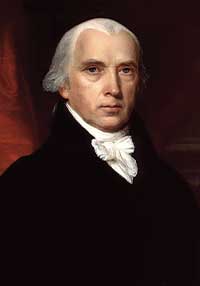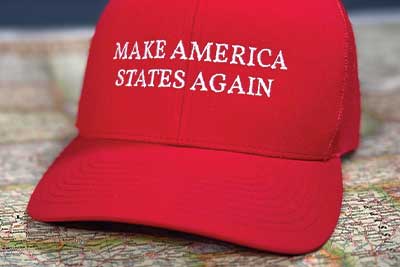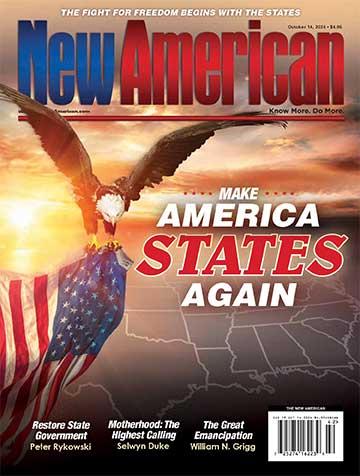Make America STATES Again
Ominous storm clouds loom over our sovereign states. But unlike most storms that move from west to east due to the jet stream, this one emerges from the east — just over the Potomac River. This gathering storm is measured not by a decrease of barometric pressure, but by the consolidation of power in the hands of the federal government. The destructive winds of this hailstorm of federal despotism threaten our system of federalism and state sovereignty. Rather than being comprised of ice, its havoc-causing hailstones are made up of a litany of federal usurpations, including:
• The U.S. Department of Education and its use of federal funds to promote disastrous one-size-fits-all indoctrination schemes (e.g., evolution, sex education, No Child Left Behind, Common Core, and critical race theory);
• Transportation Security Administration agents patting down citizens as criminals and searching their personal luggage and bags without a warrant in direct violation of the Fourth Amendment;
• The perennial reauthorization of the National Defense Authorization Act (NDAA) and the indefinite detention of American citizens without due process;
• Ever-increasing defense appropriations to fuel the military-industrial complex and U.S. foreign interventionism;
• The Affordable Care Act (aka ObamaCare) with its mandate that individuals purchase health insurance or be “taxed” as a penalty, along with its death panels targeting the elderly and disabled;
• Increasing restrictions on American citizens’ right to keep and bear arms as protected by the Second Amendment; and
• Required jabs of “emergency authorized” mRNA gene-therapy-based products and “vaccines” as a condition of employment.
Did anyone foresee a gathering storm such as this? More importantly, how do we stop it?
During the 2024 presidential election, voters have repeatedly heard calls to “Make America Great Again,” “Make America Wealthy Again,” and “Make America Healthy Again,” but one you might not have heard is “Make America STATES Again” — a solution to stop the storm and drive the federal behemoth back into its constitutional cage.
James Madison, regarded as the Father of the Constitution, warned of a “gathering storm” between the federal and state governments, and left us instructions on how to stop it in The Federalist, No. 46. The Federalist is a series of 85 papers, or essays, written by James Madison, Alexander Hamilton, and John Jay, that were originally published in New York newspapers between October 1787 and May 1788. They were addressed “To the People of the State of New York” to encourage support for ratification of the then-newly drafted Constitution for the United States. Madison’s solution in The Federalist, No. 46 is also the subject of constitutional law scholar Dr. Joe Wolverton’s book “What Degree of Madness?” Madison’s Method to Make America STATES Again, an inspirational read that every American citizen and state legislator ought to thoroughly familiarize themselves with and apply.

Empowering the states: In The Federalist, No. 46, James Madison, regarded as the Father of the Constitution, instructed the states on how to resist federal usurpations. (James Vanderlyn/Public Domain)
Madison’s Method
Originally published in the New-York Packet on January 29, 1788, The Federalist,No. 46 was written by James Madison, under the pseudonym Publius, as a continuation of his previous essay (The Federalist,No.45) about the powers of the federal and state governments under the proposed Constitution. He penned The Federalist, No. 46 specifically to address critics’ concerns that the new Constitution would result in the “consequential annihilation of the state governments.”
Madison rejected the notion that either the federal or state governments would “be able enlarge [their] sphere of jurisdiction at the expense of the other” because “it is only within a certain sphere, that the federal power can, in the nature of things, be advantageously administered.” As Madison explained in his opening, he saw the federal and state governments as being “different agents and trustees of the people, instituted with different powers, and designated for different purposes.” The federal government cannot annihilate or overstep the authority of the state governments, because the newly proposed Constitution, Madison explained, does not grant it the legal power to do so.
The powers of the proposed federal government were limited to only those specifically authorized within its sphere, or jurisdiction, by the Constitution. Likewise, the powers of the state governments are restricted from those areas that they agreed among themselves to grant to the federal government.
Madison explained the separation of powers between the federal and state governments best in The Federalist, No. 45:
The powers delegated by the proposed constitution to the federal government, are few and defined. Those which are to remain in the state governments are numerous and indefinite. The former will be exercised principally on external objects, as war, peace, negotiation, and foreign commerce; with which last the power of taxation will for the most part be connected. The powers reserved to the several states will extend to all the objects, which, in the ordinary course of affairs, concern the lives, liberties and properties of the people; and the internal order, improvement and prosperity of the state.
Limited to specific areas — mainly dealings with foreign nations, such as war, diplomacy, and trade — the federal government’s powers are “few and defined.” In virtually all other areas, the sovereign states are supreme. Nevertheless, some individuals feared that the proposed Constitution would enable the federal government to consolidate power usurped from the state governments. In The Federalist, No. 46, Madison addressed the “adversaries of the constitution” who believed that the federal and state governments would be “uncontrolled by any common superior [i.e., the people] in their efforts to usurp the authorities of each other.” He reminded them that the “ultimate authority … resides in the people alone.” And if such a clash between the federal and state governments occurs, “the first and most natural attachment of the people will be to the governments of their respective states.” Unfortunately, as Wolverton writes, “History, it seems, has not borne out Madison’s confidence in the connections of the people to their state governments.”
Madison so strongly believed that the people and state governments would never tolerate federal encroachments on their state’s authority and sovereignty that he predicted all the states would rise up to confront the federal tyrant, just as they had recently done against a foreign tyrant. “But ambitious encroachments of the federal government, on the authority of the state governments, would not excite the opposition of a single state or of a few states only. They would be signals of general alarm. Every government would espouse the common cause. A correspondence would be opened. Plans of resistance would be concerted. One spirit would animate and conduct the whole. The same combination in short would result from an apprehension of the federal, as was produced by the dread of a foreign yoke,” Madison wrote.
The very notion of the federal government overstepping its authority and encroaching upon that of the states was so inconceivable to Madison that he posed the question: “But what degree of madness could ever drive the federal government to such an extremity?” It’s from this incredulous question, which Madison asks in The Federalist, No. 46, that Wolverton titled his book. In fact, Wolverton makes five key observations about The Federalist, No. 46 that are key to understanding and applying Madison’s method to Make America STATES Again:
• Madison contended that the people and the states would never continue to elect members to Congress “ready to betray both” the people and the states that elected them.
• It was unthinkable to Madison that these “traitors,” as he called them, would vote to build up “the military establishment,” much like the military-industrial complex we see today.
• Equally unthinkable was the notion that the people and their state governments would “silently and patiently” watch “the gathering storm” and just continue to supply them with materials, or funding, to build up the military establishment and usurp more and more power for themselves from the states without opposition.
• Entertaining the “extravagant” notion of the previous three points happening and the federal government raising a powerful professional army, Madison firmly believed “that the state governments with the people on their side would be able to repel the danger.” Madison believed that the militia of armed citizens, “fighting for their common liberties,” would greatly outnumber a federal standing army.
• Finally, “the advantage of being armed, which the Americans possess over the people of almost every other nation,” coupled with their state governments having the power to appoint militia officers, would ultimately form “a barrier against the enterprises of ambition” that would be “insurmountable.” In other words, all states would band together and raise an unconquerable militia to fight against the federal government.
Regarding the first point above, until the ratification of the 17th Amendment to the Constitution, which provides for the direct election of U.S. senators by popular vote in each state, the state legislatures elected their own state’s U.S. senators. The Senate was originally intended to represent the interests of the state governments, much as ambassadors represent their nation’s interests to foreign governments, whereas the House of Representatives was to represent the interests of the people who directly elected its members.
Because of the 17th Amendment, state governments no longer have any representation in Congress, and their direct influence in the federal government is therefore neutralized. A full repeal of the 17th Amendment and a return to state legislatures electing their states’ U.S. senators in accordance with Article I, Section 3, Clauses 1 and 3 of the Constitution is vital to help Make America STATES Again.
Additionally, upholding the natural right to keep and bear arms, as protected by the Second Amendment, is paramount to making America states again and preventing a federal standing army from becoming tyrannical. As Wolverton rightly points out, during the Viriginia ratifying convention, James Madison described a standing army as the “greatest mischief that can happen.” Fellow Virginian and Founding Father George Mason likewise warned that, “once a standing army is established in any country, the people lose their liberty.”
An armed citizenry is a bulwark against any standing army. All federal gun and arms-control laws curtailing an individual’s natural right to possess weapons are unconstitutional, because such “laws” violate and interfere with the states’ ability to maintain their militias (which are not the same as today’s National Guard). The Second Amendment was intended to prohibit the federal government from restricting the inherent right of the people to be armed — an individual freedom and natural right that is absolutely essential for sovereign states to establish and maintain militias for their security. That was the original plan, and we need to stick to it.
Rightful remedy: The way to “Make America Great Again” is not simply to vote for the right person to serve as president. It’s to go back to the original understanding of the Constitution as a compact among the states and reassert state sovereignty. In other words, the solution is to Make America STATES Again. (The New American)

A Compact Among the States
Even more pressing and fundamental to stopping the storm and Make America STATES Again is understanding that the Constitution is a compact among the states. As Wolverton explains:
THE STATES CREATED the federal government, set the boundaries of its power, and reserved to themselves all other rights not specifically delegated to the new national authority. The contract containing the rights and responsibilities of the parties to this contract that created the federal government is called the Constitution. This act of collective consenting is called a compact.
The “compact” nature of the Constitution is evident in the fact that it was drafted, and every aspect of it voted on, during the Philadelphia Convention of 1787 by deputies representing the states — and the fact that the Constitution was afterward ratified by the states, in the form of special ratifying conventions held on a state-by-state basis. Article VII of the Constitution says: “The Ratification of the Conventions of nine States, shall be sufficient for the Establishment of this Constitution between the States so ratifying the Same.” (Emphasis added.) The federal government would not exist today if the states had not drafted and ratified the Constitution.
The Constitution intentionally authorizes a federal government with only “few and defined” powers, as Madison explained in The Federalist, No. 45, which are necessary to conduct certain and specific duties as an agent (or on behalf) of the states. The states created the federal government for their mutual benefit and interests. The federal government is supposed to be subordinate to the interests of the states and We the People, not the other way around!
Despite these few and defined powers, even the most passively aware and politically disinterested American today can see the gathering storm clouds of Washington routinely telling We the People and the state governments what to do. Sadly, as a result of lies repeatedly taught in government schools and by the media, Americans have been led to believe that all laws passed by Congress and signed by the president, presidential executive orders, federal regulations, and Supreme Court rulings are the “supreme Law of the Land” and must be implemented by the states as subordinates to the federal government. And should any dispute arise between the slaves and their master (i.e., the states and the federal government), once the Supreme Court makes a ruling (typically on the side of the federal government), that “settles” the matter.
This widespread belief stems from a misunderstanding of Article VI and what has long been erroneously called the “Supremacy Clause.” Nowhere does Article VI, or any other part of the Constitution, authorize or declare that the federal government and all federal laws have supremacy over state governments and state laws. When Article VI declares that the “Constitution, and the Laws of the United States which shall be made in Pursuance thereof … shall be the supreme Law of the Land,” the phrase “made in Pursuance thereof” does not mean “made in violation thereof.” Pursuance (or, to pursue something) means to follow after the object in question — in this case the Constitution.
In other words, only the Constitution and those laws that follow the Constitution — as in keeping with the Constitution — are the supreme law of the land. This implies that those “laws” not made in pursuance of the Constitution are not the supreme law of land. As such, and in accordance with their oath of office, members of the state legislatures are to regard such “laws” as nothing more than usurpations, and either ignore them or declare them to be null, void, and of no legal effect within the borders of their sovereign states. In fact, in The Federalist, No. 33, Alexander Hamilton wrote:
But it will not follow from this doctrine that acts of the larger society which are not pursuant to its constitutional powers, but which are invasions of the residuary authorities of the smaller societies, will become the supreme law of the land. These will be merely acts of usurpation, and will deserve to be treated as such. [Emphasis in original.]
It is essential that state legislators have a proper understanding of the enumerated powers of Congress to determine what is pursuant to the Constitution. The act of state legislators declaring federal acts that are not warranted by the enumerated powers in the Constitution to be “null, void, and of no legal effect” in their state is called nullification. “If nullification is to be successfully deployed and defended, states’ lawmakers must remember that the Constitution is a creature of the states and that the federal government was given very few and very limited powers over objects of national importance. Any act of Congress, the courts, or the president that exceeds that small scope is null, void, and of no legal effect. No exceptions,” emphasizes Wolverton.

Locked and loaded: Upholding the natural right to keep and bear arms, as protected by the Second Amendment, is paramount to making America states again and repelling a tyrannical federal standing army. (Reed/Adobe Stock)
The Case for Nullification
Nullification is deeply rooted in U.S. history — particularly of the American people expressing their collective interest as states. From the settlement of the American Colonies to the War for Independence, American Colonists always banded together through, and in the name of, their respective Colonies and states to resist tyranny. The people’s inherent sovereignty is expressed first and foremost through their state governments, which in turn sublet a portion of that sovereignty to the federal government. James Madison understood and explained this in The Federalist, No. 46, writing, “The federal and state governments are in fact but different agents and trustees of the people, instituted with different powers, and designated for different purposes.” (Emphasis added.)
The heart and soul of Madison’s method to Make America STATES Again is the concept and proper use of nullification. In The Federalist, No. 46, Madison understood that “the first and most natural attachment of the people will be to the governments of their respective states.” He firmly went on to say:
The disquietude [i.e., uneasiness, anxiety, or lack of tranquility] of the people, their repugnance and perhaps refusal to co-operate with the officers of the union, the frowns [or disapproval] of the executive magistracy of the state [i.e., governor], the embarrassments created by legislative devices [i.e., state legislation nullifying federal acts], which would often be added on such occasions [i.e., done frequently] would oppose in any state difficulties not to be despised; would form in a large state very serious impediments, and where the sentiments of several adjoining states happened to be in unison, would present obstructions which the federal government would hardly be willing to encounter. [Emphasis added.]
In other words, the awakened, anxious, and troubled people, acting through their state government, would refuse to comply or cooperate with federal agents; the governor of their state would likewise disapprove of the federal usurpation; the state legislature would pass legislation to nullify implementation every time the federal government usurps its authority; and if the same sentiments or feelings triggered a similar response from additional states, the federal government would not have the ability or willpower to continue, and therefore would stop. That’s how we stop the gathering storm. If we do that often enough, we can and will Make America STATES Again.
Despite efforts by socialists and historical revisionists in academia and in charge of government schools who equate nullification with the events leading up to the Civil War, nothing could be further from the truth. Nullification, as advocated by James Madison and Thomas Jefferson, is rooted in the principle that the states, as sovereign entities, have the duty to reject federal overreach. It is the “rightful remedy” against unconstitutional acts, designed to protect liberty and prevent the centralization of power. Nullification enforces and strengthens the Constitution by encouraging all parties to abide by its limitations.
Modern nullification is about restoring the proper balance of power between the states and the federal government, ensuring that laws not made in pursuance of the Constitution have no binding authority on the people. It is the states, acting in their sovereign capacity, that serve as the check on federal overreach, just as the Founders intended. Far from being a divisive relic of the past, nullification today is about upholding constitutional order and protecting the liberties of all Americans.
Every year legislation is filed in state legislatures across the country declaring federal usurpations masquerading as laws to be “null, void, and of no legal effect.” Recent examples of unwarranted federal acts targeted by state legislators include ObamaCare, federal deployments of state National Guard units to participate in undeclared wars overseas, indefinite detention of American citizens and other egregious aspects of the NDAA, curtailments of citizens’ right to keep and bear arms as protected by the Second Amendment, mRNA vaccine mandates, legal-tender laws, and the potential establishment of a Federal Reserve-based central bank digital currency.
It is imperative that these proper applications of nullification pass in each state, and that more are filed and enacted every time the federal government violates the Constitution and usurps the authority of the state governments. The more states nullify federal usurpations, thereby forcing the federal government to adhere to the original terms of the compact among the states (the Constitution), the better off, happier, and more tranquil our country will be. Frequent nullification by state legislatures of every unconstitutional federal act will create a sense of understanding between the federal and state governments, reduce tension between them, and help reinforce federalism. Nullification requires boldness. State legislators must resolutely stand on their constitutional high ground.
The opposite of nullification is subordination — the states accepting all unconstitutional federal acts, simply allowing the federal government to usurp their authority and consolidate more power. “The failure of the people to force the states to flex the muscle of nullification has led to atrophy, leaving them too weak to put up a good fight against the federal assault on the sovereignty of the states and the liberty of the people,” Wolverton rightly warns.
“What Degree of Madness?” Madison’s Method to Make America STATES Again, by Wolverton, ought to be required reading for all American citizens, especially state lawmakers. Building this awareness and understanding about nullification is essential to dispersing the dark clouds of despotism and returning the federal government to obedience to the Constitution as the Founders intended. The John Birch Society (the parent organization of The New American) is likewise committed to Madison’s cause of constitutional government and federalism, which is why it has adopted his method to Make America STATES Again as part of its agenda. To order Wolverton’s book, click here. For additional information, tools, and resources about nullification, visit JBS.org/states.



